Many parents dream of finding the perfect kindergarten for their children, a place where they can learn, play, and grow in the best possible way.
However, this quest for perfection can be misguided and unrealistic, as there is no single kindergarten that can meet every child’s needs and expectations.
Table of Contents
Instead of chasing an ideal that does not exist, parents should focus on finding quality kindergartens that offer a range of benefits for their children:
- Experienced and caring teachers who can guide and support children’s learning and development
- A nurturing and safe environment that fosters children’s well-being and happiness
- A tailored and flexible curriculum that adapts to children’s interests, abilities, and goals
- A balance between academic and non-academic activities that promote children’s cognitive, physical, social, and emotional skills
- A diversity of experiences and opportunities that expose children to different cultures, perspectives, and challenges
There Is No Such Thing as a Perfect Kindergarten Meaning is here:

Perfect Kindergarten Meaning
The Myth of Perfection
One of the reasons why parents may seek perfection in kindergartens is because they want to give their children the best start in life. They may believe that a perfect kindergarten will ensure their children’s success and happiness in the future. However, this belief is based on a myth that ignores the reality and complexity of children’s development.
Children are not machines that can be programmed to perform according to a fixed standard. They are human beings who have their own personalities, preferences, and passions. They learn and grow at different rates and in different ways. They face different challenges and opportunities in their lives. They have different strengths and weaknesses, likes and dislikes, hopes and fears.
Therefore, a kindergarten that seems perfect on paper may not suit a child’s needs in practice. For example, a kindergarten that has a rigorous and structured curriculum may not appeal to a child who prefers to learn through play and exploration. A kindergarten that has a large and diverse student body may not suit a child who needs more individual attention and support. A kindergarten that has a lot of rules and regulations may not fit a child who values creativity and freedom.
Instead of trying to fit children into a mold of perfection, parents should embrace their children’s imperfection. Imperfection is not a flaw, but a source of learning and growth. By accepting and celebrating their children’s imperfection, parents can help them to:
- Learn from their mistakes and failures, and develop resilience and perseverance
- Explore their interests and passions, and discover their talents and potential
- Express their thoughts and feelings, and develop confidence and self-esteem
- Respect and appreciate their differences and similarities, and develop empathy and compassion
The Quest for Quality
Rather than pursuing perfection, parents should prioritize quality in kindergartens. Quality is not a fixed or objective measure, but a relative and subjective one. Quality depends on the context and the criteria that parents use to evaluate kindergartens. Quality also varies depending on the child and the family. What works for one child may not work for another. What matters to one family may not matter to another.
Therefore, parents should not rely on external or superficial indicators of quality, rankings, ratings, or reviews. Instead, they should use their own judgment and intuition, and consider their own values and goals. They should also involve their children in the decision-making process, and listen to their opinions and feedback.
Some of the questions that parents can ask themselves and their children when looking for quality kindergartens are:
- Does the kindergarten have a clear and consistent vision and mission that aligns with our values and goals?
- Does the kindergarten have qualified and dedicated teachers who can meet our child’s needs and expectations?
- Does the kindergarten have a supportive and respectful culture that fosters our child’s well-being and happiness?
- Does the kindergarten have a relevant and engaging curriculum that stimulates our child’s curiosity and creativity?
- Does the perfect kindergarten have a variety of activities and resources that enhance our child’s skills and knowledge?
- Does the kindergarten have a strong and positive relationship with us and the community?
What makes a successful Kindergarten?

Kindergarten Activities
Embracing Diversity:
The diversity among children is vast, encompassing various learning styles, developmental paces, and cultural backgrounds. This inherent diversity poses a challenge to the notion of a single, flawless kindergarten model. Acknowledging and embracing this diversity becomes imperative in creating an inclusive and supportive educational atmosphere.
Developmental Variability:
Children’s development is multifaceted, spanning cognitive, social, and emotional domains. A “perfect” kindergarten fails to accommodate the differing paces and strengths in these areas. Instead, educators must focus on creating an adaptable environment that allows each child to flourish according to their unique growth trajectory.
The Role of Play-Based Learning:
Kindergarten serves as a foundational period for learning through play and exploration. However, the pursuit of perfection often sidelines the significance of play-based education in favor of rigid academic standards. Recognizing the innate curiosity of children and fostering creativity through play becomes vital in nurturing a love for learning.
Prioritizing Social-Emotional Development:
Beyond academic achievements, kindergarten marks a critical phase for social and emotional growth. A flawless kindergarten overlooks the importance of creating a nurturing social environment where children learn empathy, communication, and resilience – skills vital for their holistic development.
Collaboration between Educators and Families:
The responsibility of a child’s education extends beyond the classroom. The partnership between educators and families plays a pivotal role in shaping a child’s educational journey. Acknowledging this collaboration and involving families in the learning process ensures a more comprehensive and enriching kindergarten experience.
Flexibility and Continuous Improvement:
Static ideals of perfection hinder educational progress. Kindergarten should be a space that evolves with time and incorporates innovative approaches aligned with the latest research in child development. Embracing flexibility and continuous improvement allows educators to adapt to the evolving needs of young learners.
Summery of Why There Is No Such Thing as a Perfect Kindergarten
In conclusion, the pursuit of a perfect kindergarten is an unattainable goal. Embracing imperfection allows educators and parents to recognize the individuality and complexities of children, fostering an inclusive and responsive educational environment. By acknowledging diversity, promoting play-based learning, prioritizing social-emotional development, and encouraging collaboration, we pave the way for a more effective and fulfilling kindergarten experience.

